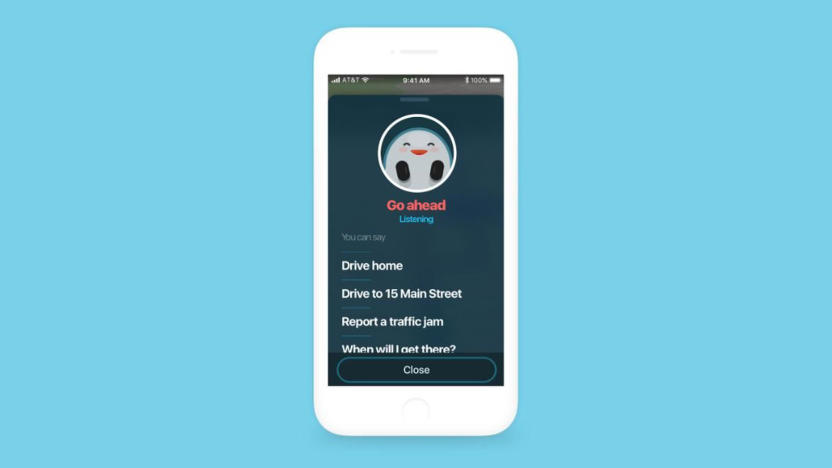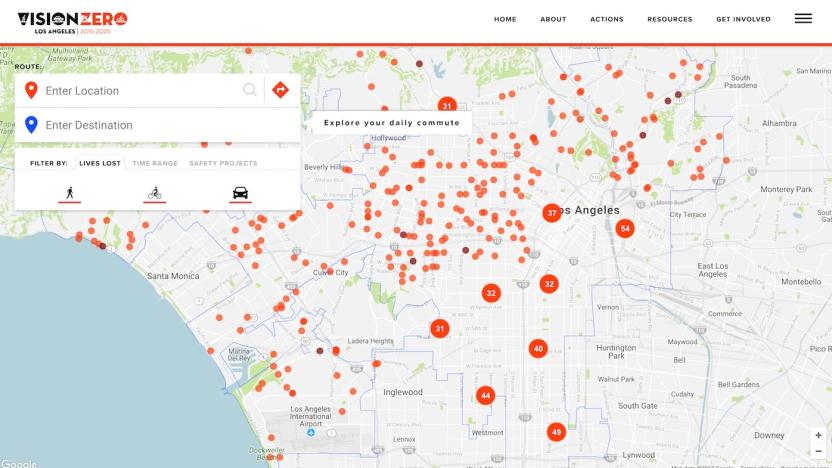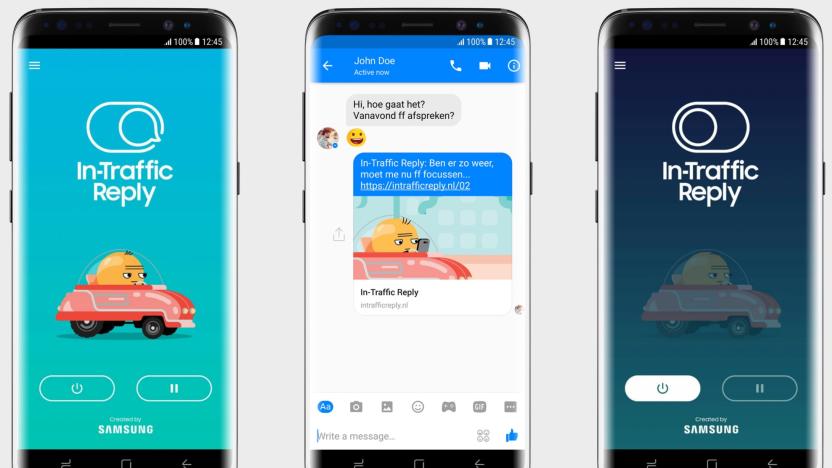distracteddriving
Latest

Android Auto can unlock your phone with a swipe
Google understandably shuts down easy access to your phone when Android Auto is turned on, since you're supposed to be focused on the road. But what if you do need access to your phone while it's still paired with your car? It should be easy from now on: Google has quietly added swipe-to-unlock access to your phone while Android Auto is active. If you absolutely need to pull over and check a third-party messaging app (or have a passenger do it for you), you don't have to jump through hoops to get to your home screen.

Florida may finally implement full ban on texting while driving
There are 43 states that currently treat texting while driving as a primary offense, but Florida isn't one of them -- you have to break another law before texting enters the picture. However, less-than-attentive commuters might not get away with it for much longer. The state legislature is about to consider a bill that would make texting a primary offense. In other words, officers could finally pull drivers over without waiting until they speed or otherwise put other road-goers at risk.

Waze adds hands-free navigation to keep your eyes on the road
Waze has a number of measures to reduce distractions and keep your eyes on the road ahead, but there has been one inescapable distraction: you usually have to touch the screen to get things done. That's a problem, especially in areas where distracted driving laws make it illegal to poke at your phone while on the move. It shouldn't be a problem for much longer. Waze's latest update includes a hands-free navigation option that lets you handle most tasks using only your voice. Say "OK, Waze" and you can navigate to a destination or report a traffic jam without losing focus.

LA fights soaring pedestrian deaths with an interactive map
Open data can be an incredibly powerful tool, but it still requires context and people to actually pay attention to the information for it to be valuable. Los Angeles has discovered this the hard way. Its Vision Zero initiative aims to eliminate traffic deaths by 2025, but compared to other cities with similar programs, LA is coming up short in terms of results. After the program's first full year (2016), fatalities rose by some 43 percent according to the Los Angeles Times. There are a number of reasons for this, including more pedestrian and bicycle traffic, distracted driving and driving under the influence. To combat the rising number, the city looked to data as a means of discerning the most fatal roadways.

Nissan imagines Faraday cages in cars will stop phone use
Despite the many tools developed to help us down our phones while driving -- from the simple Bluetooth headset to apps that automatically reply to texts -- it appears we just can't stop fiddling with the things when we're behind the wheel. And even if your eyes are fixed on the road, barking hands-free voice commands can still render you dangerously distracted. Simply ignoring your phone is the most sensible thing to do, and Nissan has come up with the most elaborate, over-engineered way of ensuring that happens: Putting a Faraday cage inside the driver's armrest.

Samsung's auto-reply app fights distracted driving
Let's be honest: too many of us are using our phones while driving. It's a problem and it's dangerous, but we do it anyway. Samsung knows this and has come up with a new app cleverly named In-Traffic Reply to help. The app, currently in beta, aims to keep you safe while allowing you to answer messages you get while you're behind the wheel.

US proposes a phone 'driver mode' to reduce in-car distractions
Smartphones already have car-optimized interfaces like Android Auto and Apple CarPlay, and you'll occasionally see safety measures that shut off features (and enable others) while you're driving. However, the National Highway Traffic Safety Administration wants to do better. It's proposing voluntary guidelines that would both encourage phone makers to both include pairing with infotainment systems (much like Android Auto and CarPlay) and, crucially, a "driving mode" that cuts back on distractions. It would have a simpler interface that minimizes the time you spend looking away from the road, and either disables or downplays features that you don't need while on the move.

Johnnie Walker's drunk-driving VR experience lacks subtlety
You've probably considered the importance of avoiding drinking and driving, but I'm guessing you've never experienced the consequences of it in VR. Johnnie Walker teamed up with Samsung to create Decisions, a virtual reality video that lets you see, first-hand and in 360 degrees, what happens when you drink and drive. The idea is to make the consequences so real that you'll be deterred from driving while intoxicated. I tried out the full experience this week (complete with a vibrating "4D" chair), and left feeling less chastened than I thought I would.

New York bill would have police scan your phone after a crash
It may be relatively difficult for police to catch people texting while driving, but one proposed New York law would make it near-impossible to avoid detection if that distraction leads to a crash. A new state Senate bill would let police submit you to a "textalyzer" (basically, a device that scans for recent phone activity) after an accident -- you'd actually lose your license if you refused. Just as the Breathalyzer impacted drunk driving, the device would ideally help identify the cause of a crash and hold people accountable for dangerous behavior behind the wheel.

In-car voice commands cost you 27 seconds of safety
We all know that taking your eyes off the road is a bad idea, but now researchers have added another paper to confirm that using voice commands is just as unwise. A team from the University of Utah, in partnership with the American Automobile Association, believes that the mental effort of driving and talking on your phone is still dangerous. According to the research, it takes a full 27 seconds after completing a distracting task — queuing up a song even with your voice alone — before your brain is fully able to concentrate on the art of driving.

Glympse for Auto shares your car's location without distractions
You no longer have to fiddle with your smartphone (or an in-car interface) to share your location while on the road. Glympse has trotted out Glympse for Auto, an Android app that lets you send your position with a minimum of distractions. You only have to tell it who can see your whereabouts and for how long using a big, car-friendly interface -- after that, you're free to focus on driving. It'll even show up on your infotainment display if you're using either Pioneer's AppRadio 3 or MirrorLink-equipped cars from Volkswagen and Peugeot (more in-car systems will work soon, Glympse says). While this hands-off approach won't get you home any faster, it should spare you from taking risks just to prove that you're still stuck in traffic.

Toyota's VR driving simulator teaches teens to focus on the road
You can tell people that distracted driving is bad and make laws preventing it, but that won't necessarily make the dangers sink in. Toyota thinks it has a way to convey the risks to impressionable minds, however. Its new TeenDrive365 education initiative includes an Oculus Rift-powered virtual reality simulator that challenges both teens and parents to keep their eyes on the road despite a horde of distractions, ranging from text messages to talkative friends in the back seats. As you'd guess, the VR is meant to produce a more realistic experience -- it's more tempting to look down at your imaginary phone than it would be if you were staring at a regular screen.

Intel Labs measures cognitive workload of distracted drivers, we go eyes-on with the demo (video)
Many studies have shown that any kind of distracted driving is a bad thing, but Intel wanted to take a closer look at our driving behavior to determine if we could avoid it in the first place. Paul Crawford, a senior research scientist in Intel's Interaction and Experience Research Lab, sought to do just that in a comprehensive investigation that seeks to understand not just where drivers are looking, but how they're thinking. By doing this, Intel hopes to alert the driver of any mental warning signs before he or she even gets behind the wheel. At a recent Research @ Intel event in San Francisco, Crawford used a racing car gaming set-up to demonstrate both visual and mental diversions with eye-tracking software and a functional near-infrared spectrometer headband. The latter is used to gauge the metabolic activity and cognitive workload of the brain under different driving conditions, which in this case fluctuated between a peaceful drive and a high-speed chase. Crawford also threw in a few questions and mathematical problems at the test subject to complicate matters. As you might expect, the brain was highly active during the more challenging scenarios and less so in the other. Crawford told us he hopes that the findings will point to ways we can optimize our environmental conditions and taskloads so that we can perform better, not just when driving but in everyday tasks as well. To see the demo in action and hear Crawford's words for yourself, check out the video after the break. Michael Gorman contributed to this report.

US Department of Transportation posts guidelines for reducing in-car distractions
We all know by now that directly interacting with a phone while driving is a very bad idea. There are many more potential distractions at play in a car, however, and the US Department of Transportation has just published the first phase of guidelines to help infotainment device and vehicle makers keep drivers' eyes on the road. Many of them are logical recommendations for avoiding text, video and the web while on the move, although the federal agency suggests curbs that would surprise those with cutting-edge rides. While the DOT agrees that hands-free calls are safer, it still sees an added degree of risk from using them; it's not a big fan of GPS systems that introduce 3D or photorealism, either, as they potentially distract from the navigation at hand. The current guidelines aren't hard and fast rules, but it's clear the DOT will be watching companies closely -- and when the advice is just one part of a three-part series, we'd expect close scrutiny of phones and other mobile devices before too long.

Samsung announces Drive Link, a car-friendly app with MirrorLink integration
Until self-driving cars become mainstream, it's best to keep eyes on roads and hands off phones. With this in mind, Samsung's debuting Drive Link, an app that balances in-car essentials with driver safety, complete with approval from the no-nonsense Japanese Automotive Manufacturers Association. It's all about the bare essentials -- navigation, hands-free calling and audiotainment from your phone-based files or TuneIn. Destinations can be pulled from S Calendar appointments or texts without trouble, and the text-to-speech feature means you won't miss a message, email or social media update. The best bit is that via MirrorLink, all these goodies can be fed through compatible dash screens and speaker systems. Drive Link is available now through Sammy's app store for Europeans sporting an international Galaxy S III, and will be coming to other ICS handsets "in the near future."

Parrot Minikit Neo helps you focus on driving, making off-handed Matrix references
Like talking on the phone while driving, but hate all of the crashing it sometimes entails? Parrot's bringing its Minikit Neo to the states later this year, bringing a free Android / iPhone app along for the ride that helps you locate your car, set parking meter fill-up reminders, schedule driving breaks and set auto-replies like, "I'm driving and will call you later," for those times when you're driving and will call people later. The sun-visor-clipping car accessory can connect two Bluetooth-enabled devices simultaneously and features a vibration sensor that'll turn it on and off as you enter and exit the vehicle. The Neo will arrive stateside in September for $100.

Scosche cellControl locks your device while driving, tattles on your text habit
Trying to keep the points off your record, but just can't resist the urge to tweet, text and talk behind the wheel? Maybe it's time you gave up on that whole "self-restraint" schtick and leaned on technology to keep your cellular inhibitions in check. Scosche's cellControl might do the trick, it pairs bit of bluetooth-enabled automotive hardware with a feature-blocking smartphone app to keep your handset under lockdown when you're on the go. It even rats you out if you deactivate or uninstall the system -- automatically sending a text message or email to a "designated administrator," just in case you fall off the wagon. The system boasts compatibility with over 1200 devices across Android, Blackberry, Symbian and Windows Mobile 5 and 6. Artificial restraint will set you back $130, you know, in case self-control and other distracted driving apps aren't doing the trick. Hit the break for the system's official press release.

Auto-insurance researchers: 'Cell phone bans don't help reduce crashes'
All those fancy in-car docks and voice navigation? Utterly pointless. At least according to the Insurance Institute for Highway Safety, who reckons that it's not the phone that's the issue, but "the full spectrum of things that distract." The IIHS (funded by a group of car insurers) compared crash data between states that had instituted cell phone bans and those that hadn't. According to its research, while the ban had reduced phone use (whoa, really?), it hadn't helped reduce crash rates. The National Transportation Safety Board has presented several studies linking cell phone use to an increased chance of crashing and their latest proposals would ban most hands-free systems found in major car makers' vehicles today. Hear that? That was the sound of hundreds of third-party accessory manufacturers recoiling in horror.

Sprint announces Drive First app to stop distracted driving, expects you to pay $2/month for it
Driving whilst distracted is becoming enough of a problem for our various government agencies to start looking into ways to proactively prevent it, rather than just pass laws against it, but Sprint is being more proactive than most. It's announced an app called Drive First, developed by Location Labs, which won't be available until sometime in the third quarter. The app runs on Android and basically puts your phone into lock-down mode "when driving is detected," automatically sending incoming calls to voicemail, auto-replying to texts that you're unavailable, and preventing you from using much of any applications outside mainstream navigation fare. As always with these apps we're not sure just how they'll differentiate between driving and, say, sitting on a train, and we're guessing they'll be just as effective at locking out those riding shotgun, but for parents worrying about whether Junior is texting when he should be driving home from band practice it could be a good solution. That solution, however, will cost those 'rents $2 per month -- and certainly won't earn them any love from their angsty teen.

New York DOT now adding 2-point driver's license penalty for talking on the phone while driving
It has been illegal to talk on a cell phone while driving in New York for years now, but the state has just steeply upped the penalties associated. The $100 fine which is currently imposed has been joined by a 2-point penalty on the driver's record -- which should serve as a real deterrent for most. The DMV has estimated that one in five crashes now involve so-called distracted drivers, resulting in about 5,000 deaths last year. So please, keep your eyes on the road.










